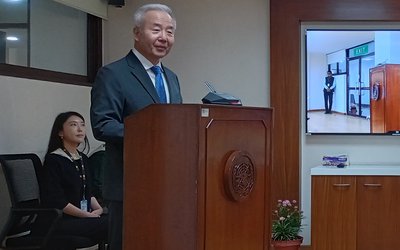
If an earthquake of 8. 6 on the Richter scale rocks Nepal, where earthquakes measuring 7.9 and 7.2 magnitudes have hit only last year, how will the country’s disaster agencies cope? Will they be able to move in for rescue given the likely devastation of scales which will be much higher than the two of the last April and May?
At a time when geologists are predicting that Nepal will face earthquakes of over 8 on the Richter scale any time, and a massive devastation, Nepal Army and US Pacific Command (USPACOM0 organized an international workshop where experts analyzed the capability of Nepal’s security agencies, civil service and other agencies and evaluated their performance in handling the recent earthquakes.
Participated in by 240 persons from 18 different countries, including 60 officers from Nepal Army, high level government officials and civil society members from the region, the Multinational Planning Augmentation Team (MPAT) Tempest Express-28 Workshop extensively discussed Nepal’s recent earthquakes, the rescue and relief operation, the rehabilitation process and the role played by security agencies, international community and civil society.
Nepal Army Suggestions
Although Nepal has taken several steps, Nepal Army suggests that there is a need for establishing a functional coordination mechanism with decision making bodies -- such as establishment of a Joint Coordination Committee (JCC) to minimize present gaps in the coordination mechanism.
Given the experiences of the recent earthquakes, Nepal Army suggested that there is a requirement of Airport Coordination Center (ACC) to end the chaos during incoming foreign support. It suggested an ad-hoc organogram to include Security Forces (Nepal Army, Armed Police Force-APF, Nepal Police, and National Investigation Department NID), TIA, MOHA, line ministries and Custom Authority representatives.
One of the future challenges in handling the disaster will be the airspace and airport management. On air apace and airport management, Nepal Army found air space use and mismanagement of airport space were cause of conflict. It recommended centres to be established at TIA and all Regional Airports by airport authorities in coordination with NA aviation, formation, and units at Local Level.
Establishment of Forward Area Refueling Point (FARP) at HSA/Lgs Base/Distribution Point in coordination with Nepal Oil Corporation(NOC) and maximum pre positioning of Rubber Folded Tank (RFT).
Nepal Airline’s limited ground handling equipment at International/Regional Airports slowed down the support efforts. Nepal army recommended procurement acquisition of ground handling equipment and government should request for required equipment from incoming Foreign Military and other assistance teams.
Nepal Army suggested having programs for capacity building of Nepalese Army, Nepal Police and APF. Nepal Army also recommended properly equipped and trained manpower, reinforced as under heavy equipment should be self sufficient Air assets.
In case the country's road network and air facilities are badly affected, Nepal should have standby agreements for using air facilities (airport, refueling, crafts etc.) with neighboring countries, especially with China, India and Bangladesh. Although Nepal is one of the most vulnerable countries for disaster, Nepal has no standby agreements with neighboring countries for using their air facilities.
“This program will help to enhance the capabilities of Nepal Army and other security agencies at the time of disaster in the coming days,” said COAS General Rajendra Chhetri.
Bill Berger, Senior Regional Advisor for South Asia for OFDA, hailed the role played by Nepal Army, Nepal Armed Police and Nepal Police during the two earthquakes of April and May. “I started my career from Nepal taking part in 1989 earthquake and flood of 1993. There are more frequent disasters now-a-days,” said Berger.
Defense secretary Jaya Mukunda Khanal and Home Secretary Narayan Gopal Malegu also spoke about the importance of the workshop in the Nepalese context.
The American Embassy and U.S. Pacific Command (PACOM) sponsored the Multinational Planning and Augmentation Team (MPAT) “TEMPEST EXPRESS” Disaster Response Exercise which was co-hosted with the Nepalese Army from 10-18 March 2016. This exercise incorporated military, civilian and NGO participants from over twenty different countries throughout Asia.
“The United States remains committed to partnering in the development of Nepal’s disaster management capabilities. We remain proud to work closely with our counterparts in Nepal’s government and security forces,” said Berger.
Earthquake Threat
According to a recent study a massive underground fault line that ruptured last year, causing a killer earthquake in Nepal, is still under tremendous strain underneath Kathmandu.
“Another major tremor could happen within years or decades rather than the centuries that typically elapse between quakes,” wrote researchers in the journal Nature Geosciences.
Lead author John Elliott of Oxford University said the rupture, shooting upward through the fault line from deep below, stopped abruptly 11km (6.8 miles) beneath the Nepalese capital, leaving an unbroken upper portion nearer the surface.
High-resolution satellite images revealed “only a small amount of the earthquake reached the surface”, he said in a press statement. The unbroken upper part of the fault, added Elliott, “is continuously building up more pressure over time”.
“As this part of the fault is nearer the surface, the future rupture of this upper portion has the potential for a much greater impact on Kathmandu if it were to break in one go in a similar-sized event to that of April 2015,” he said.
Seismologists say Nepal rests on a major fault line between two tectonic plates. One bears India and pushes north and east at a rate of about 2cm (0.8 inches) per year against the other, which carries Europe and Asia.
A study in the same journal warned just eleven months ago that last year’s tremors had only partially relieved stress on the length of the fault line, and said chances for a big tremor were as high as before.
“Unfortunately, there is no way of predicting precisely when another earthquake will take place,” Elliot said. “It’s simply a case of countries and cities making sure they are well prepared for when it does happen.”
Scientists aren't sure exactly why the quake didn't wreak more havoc, but another temblor, even of similar magnitude, to hit the area may not be so forgiving, the researchers said.
And past seismological assessments suggest the fault that ruptured still has energy equaling about 33 to 50 feet (10 to 15 meters) of motion that must be released, which could lead to even bigger earthquakes. The April 25 earthquake caused the fault at the boundary of the Indian and Asian plates to shift about 10 feet (3 m), according to the U.S. Geological Survey.
The region's seismic history was also a sign- this is the 5th biggest earthquake in Kathmandu in the last 205 years. The problem wasn't the earthquake, but its aftermath, due to Nepal’s 6.5% population growth rate, and its status as one of the world’s highest urban densities. Lack of building codes led people to cluster in non-engineered homes without concern to earthquake safety.
Given the looming threat of major earthquake, the Multinational Planning Augmentation Team (MPAT) Tempest Express-28 Workshop carried its own importance.

Keshab Poudel
Poudel is the editor of New Spotlight Magazine.
- FM Dr. Deuba’s India Visit: Mission Aborted
- Mar 26, 2025
- AMBASSADOR MAEDA TORU: Warm Regards
- Mar 24, 2025
- PRO-MONARCHY MOVEMENT: Rising Dissatisfaction
- Mar 23, 2025
- Dr. PRABIN MANANDHAR: Person With Humility
- Mar 16, 2025
- US SUSPESION OF GRANT: Impact On Nepal
- Mar 10, 2025















